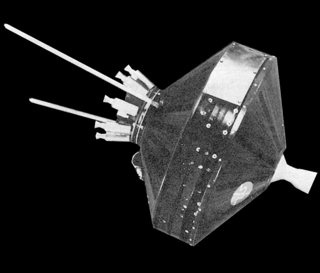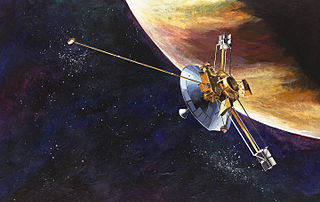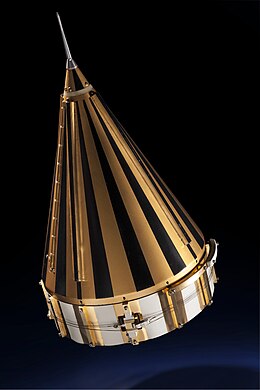
The Mariner program was conducted by the American space agency NASA to explore other planets. Between 1962 and late 1973, NASA's Jet Propulsion Laboratory (JPL) designed and built 10 robotic interplanetary probes named Mariner to explore the inner Solar System - visiting the planets Venus, Mars and Mercury for the first time, and returning to Venus and Mars for additional close observations.

Pioneer 11 is a NASA robotic space probe launched on April 5, 1973, to study the asteroid belt, the environment around Jupiter and Saturn, solar winds, and cosmic rays. It was the first probe to encounter Saturn, the second to fly through the asteroid belt, and the second to fly by Jupiter. Later, Pioneer 11 became the second of five artificial objects to achieve an escape velocity allowing it to leave the Solar System. Due to power constraints and the vast distance to the probe, the last routine contact with the spacecraft was on September 30, 1995, and the last good engineering data was received on November 24, 1995.

The Pioneer programs were two series of United States lunar and planetary space probes exploration. The first program, which ran from 1958 to 1960, unsuccessfully attempted to send spacecraft to orbit the Moon, successfully sent one spacecraft to fly by the Moon, and successfully sent one spacecraft to investigate interplanetary space between the orbits of Earth and Venus. The second program, which ran from 1965 to 1992, sent four spacecraft to measure interplanetary space weather, two to explore Jupiter and Saturn, and two to explore Venus. The two outer planet probes, Pioneer 10 and Pioneer 11, became the first two of five artificial objects to achieve the escape velocity that will allow them to leave the Solar System, and carried a golden plaque each depicting a man and a woman and information about the origin and the creators of the probes, in case any extraterrestrials find them someday.

Pioneer 0 was a failed United States space probe that was designed to go into orbit around the Moon, carrying a television camera, a micrometeorite detector and a magnetometer, as part of the first International Geophysical Year (IGY) science payload. It was designed and operated by the Air Force Ballistic Missile Division as the first spacecraft in the Pioneer program and was the first attempted launch beyond Earth orbit by any country, but the rocket failed shortly after launch. The probe was intended to be called Pioneer, but the launch failure precluded that name.

Pioneer 2 was the last of the three project Able space probes designed to probe lunar and cislunar space. The launch took place at 07:30:21 GMT on 8 November 1958. After Pioneer 1 had failed due to guidance system deficiencies, the guidance system was modified with a Doppler command system to ensure more accurate commands and minimize trajectory errors. Once again, the first and second stage portion of the flight was uneventful, but the third stage of the launch vehicle failed to ignite, making it impossible for Pioneer 2 to achieve orbital velocity. An attempt to fire the vernier engines on the probe was unsuccessful and the spacecraft attained a maximum altitude of 1,550 km (960 mi) before reentering Earth's atmosphere at 28.7° N, 1.9° E over NW Africa. A small amount of data was obtained during the short flight, including evidence that the equatorial region around Earth has higher flux and higher energy radiation than previously considered and that the micrometeorite density is higher around Earth than in space. The reason for the third stage failure was unclear, but it was suspected that the firing command from the second stage, which contained the guidance package for the entire launch vehicle, was never received, possibly due to damage to electrical lines during staging.

Pioneer 1 was an American space probe, the first under the auspices of NASA, which was launched by a Thor-Able rocket on 11 October 1958. It was intended to orbit the Moon and make scientific measurements, but due to a guidance error failed to achieve lunar orbit and was ultimately destroyed upon reentering Earth's atmosphere. The flight, which lasted 43 hours and reached an apogee of 113,800 km, was the second and most successful of the three Thor-Able space probes.

Pioneer 3 was a spin-stabilized spacecraft launched at 05:45:12 GMT on 6 December 1958 by the U.S. Army Ballistic Missile Agency in conjunction with the NASA, using a Juno II rocket. This spacecraft was intended as a lunar probe, but failed to go past the Moon and into a heliocentric orbit as planned. It did however reach an altitude of 102,360 km before falling back to Earth. The revised spacecraft objectives were to measure radiation in the outer Van Allen radiation belt using two Geiger-Müller tubes and to test the trigger mechanism for a lunar photographic experiment.

Luna 1, also known as Mechta, E-1 No.4 and First Lunar Rover, was the first spacecraft to reach the vicinity of Earth's Moon, and the first spacecraft to be placed in heliocentric orbit. Intended as an impactor, Luna 1 was launched as part of the Soviet Luna programme in 1959.

Pioneer P-30 was intended to be a lunar orbiter probe, but the mission failed shortly after launch on September 25, 1960. The objectives were to place a highly instrumented probe in lunar orbit, to investigate the environment between the Earth and Moon, and to develop technology for controlling and maneuvering spacecraft from Earth. It was equipped to estimate the Moon's mass and topography of the poles, record the distribution and velocity of micrometeorites, and study radiation, magnetic fields, and low frequency electromagnetic waves in space. A mid-course propulsion system and injection rocket would have been the first United States self-contained propulsion system capable of operation many months after launch at great distances from Earth and the first U.S. tests of maneuvering a satellite in space.
Kosmos 21 was a Soviet spacecraft. This mission has been tentatively identified by NASA as a technology test of the Venera series space probes. It may have been an attempted Venus impact, presumably similar to the later Kosmos 27 mission, or it may have been intended from the beginning to remain in geocentric orbit. In any case, the spacecraft never left Earth orbit after insertion by the Molniya launcher. The orbit decayed on 14 November 1963, three days after launch.

A trans-lunar injection (TLI) is a propulsive maneuver used to set a spacecraft on a trajectory that will cause it to arrive at the Moon.

A gravity assist, gravity assist maneuver, swing-by, or generally a gravitational slingshot in orbital mechanics, is a type of spaceflight flyby which makes use of the relative movement and gravity of a planet or other astronomical object to alter the path and speed of a spacecraft, typically to save propellant and reduce expense.

A Moon landing or lunar landing is the arrival of a spacecraft on the surface of the Moon. This includes both crewed and robotic missions. The first human-made object to touch the Moon was the Soviet Union's Luna 2, on 13 September 1959.
In aerospace engineering, spin stabilization is a method of stabilizing a satellite or launch vehicle by means of spin, i.e. rotation along the longitudinal axis. The concept originates from conservation of angular momentum as applied to ballistics, where the spin is commonly obtained by means of rifling. For most satellite applications this approach has been superseded by three-axis stabilization.

Explorer 5 was a United States satellite with a mass of 17.43 kg (38.4 lb). It was the last of the original series of Explorer satellites built, designed, and operated by the Jet Propulsion Laboratory.

The exploration of Jupiter has been conducted via close observations by automated spacecraft. It began with the arrival of Pioneer 10 into the Jovian system in 1973, and, as of 2023, has continued with eight further spacecraft missions in the vicinity of Jupiter. All of these missions were undertaken by the National Aeronautics and Space Administration (NASA), and all but two were flybys taking detailed observations without landing or entering orbit. These probes make Jupiter the most visited of the Solar System's outer planets as all missions to the outer Solar System have used Jupiter flybys. On 5 July 2016, spacecraft Juno arrived and entered the planet's orbit—the second craft ever to do so. Sending a craft to Jupiter is difficult, mostly due to large fuel requirements and the effects of the planet's harsh radiation environment.
JunoCam is the visible-light camera/telescope onboard NASA's Juno spacecraft currently orbiting Jupiter. The camera is operated by the JunoCam Digital Electronics Assembly (JDEA). Both the camera and JDEA were built by Malin Space Science Systems. JunoCam takes a swath of imaging as the spacecraft rotates; the camera is fixed to the spacecraft, so as it rotates, it gets one sweep of observation. It has a field of view of 58 degrees with four filters.

Explorer S-1, also known as NASA S-1 or Explorer 7X, was a NASA Earth science satellite equipped with a suite of scientific instruments to study the environment around the Earth. The spacecraft and its Juno II launch vehicle were destroyed five seconds after launch on 16 July 1959, in a spectacular launch failure caused by complications with the launch vehicle's power supply. A relaunch of the mission in October 1959, Explorer 7 (S-1A), was successful.

















